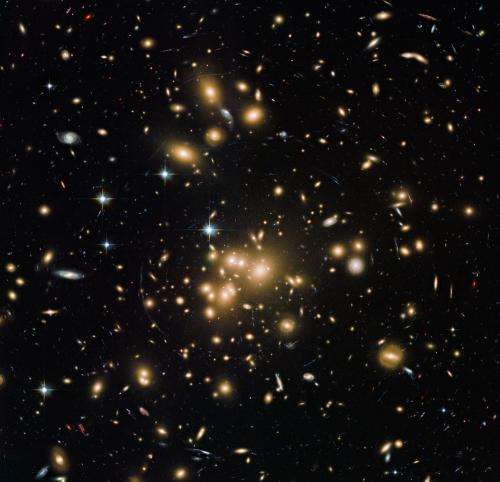Hubble uncovers largest known group of star clusters, clues to dark matter

(Phys.org) —NASA's Hubble Space Telescope has uncovered the largest known population of globular star clusters, an estimated 160,000, swarming like bees inside the crowded core of the giant grouping of galaxies known as Abell 1689.
An international team of astronomers used Hubble's Advanced Camera for Surveys to discover this bounty of stellar fossils and confirm such compact groupings can be used as reliable tracers for dark matter, the invisible gravitational scaffolding on which galaxies are built.
"We show how the relationship between globular clusters and dark matter depends on the distance from the center of the galaxy grouping," Karla Alamo-Martinez of the Center for Radio Astronomy and Astrophysics of the National Autonomous University of Mexico in Morelia. "In other words, if you know how many globular clusters are within a certain distance, we can give you an estimate of the amount of dark matter."
Alamo-Martinez is lead author of a paper on the findings published in the Sept. 20 edition of The Astrophysical Journal, and part of a team led by John Blakeslee of National Research Council Canada's Herzberg Institute of Astrophysics at the Dominion Radio Astrophysical Observatory in Victoria, British Columbia.
Globular clusters, dense bunches of hundreds of thousands of stars, are the homesteaders of galaxies. They contain some of the oldest surviving stars in the universe. Almost 95 percent of globular cluster formation occurred within the first 1 billion to 2 billion years after our universe was born in the theorized Big Bang 13.8 billion years ago.
Studying globular clusters is critical to understanding the early, intense star-forming events that mark galaxy formation. Understanding dark matter can yield clues on how large structures such as galaxies and galaxy clusters were assembled billions of years ago.
The globular star cluster in Abell 1689 is roughly twice as large as any other population found in previous globular cluster surveys—in comparison, our Milky Way galaxy hosts about 150—and constitutes the most distant such systems ever studied, at 2.25 billion light-years away. The Hubble study shows most of the globular clusters in Abell 1689 formed near the center of the galaxy grouping, which contains a deep well of dark matter. The farther away from the galaxy core Hubble looked, the fewer globular clusters it detected. This observation corresponded with a comparable drop in the amount of dark matter, based on previous research.
"The globular clusters are fossils of the earliest star formation in Abell 1689, and our work shows they were very efficient in forming in the denser regions of dark matter near the center of the galaxy cluster," Blakeslee said. "Our findings are consistent with studies of globular clusters in other galaxy clusters, but extend our knowledge to regions of higher dark matter density."
Peering deep inside the heart of Abell 1689, Hubble detected the visible-light glow of 10,000 globular clusters, some as dim as 29th magnitude, which is 1 one-billionth the faintness of the dimmest star that can be seen with the naked eye. Based on that number, Blakeslee's team estimated that more than 160,000 globular clusters are huddled within a diameter of 2.4 million light-years.
"Even though we are looking deep into the cluster, we're only seeing the brightest globular clusters, and only near the center of Abell 1689 where Hubble was pointed," he said.
More information: A paper describing the observations of globular clusters within Abell 1689, entitled "The rich globular cluster system of Abell 1689 and the radial dependence of the globular cluster formation efficiency", will appear in the 20 September issue of The Astrophysical Journal : iopscience.iop.org/0004-637X/775/1/20/
Journal information: Astrophysical Journal
Provided by ESA/Hubble Information Centre




















